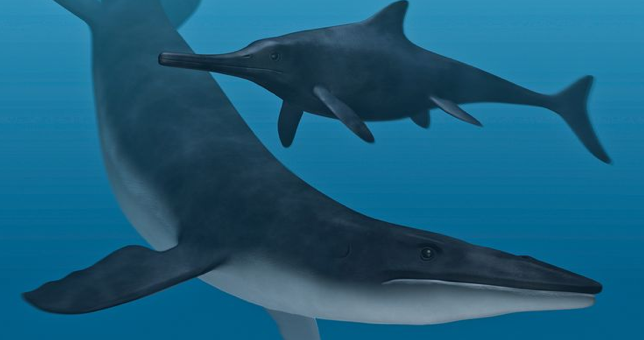We're open daily! View holiday hours
Science News
Ancient Colors and Worm Glue
January 17, 2014
by Molly Michelson

Science Today is always looking out for you! Here are some recent headlines and projects we didn’t want you to miss….
Ancient Colors
Several years ago, we produced a video on dinosaur colors. Using fossilized melanosomes, researchers could determine the colors of feathered dinosaur species. Since then, we’ve covered more research on dinosaur and early bird colors using a similar process. So now it’s time to catch you up on the latest and greatest—early marine reptile colors.
Looking at fossilized skin tissues from three early sea creatures—a 55 million-year-old leatherback turtle, a 85 million-year-old mosasaur and a 196-190 million-year-old ichthyosaur—researchers at Lund University in Sweden established that these ancient marine reptiles were, at least partially, dark in color. This dark gray and black shading probably contributed to more efficient thermoregulation, as well as providing means for camouflage and protection against harmful UV radiation.
“Our results really are amazing. The pigment melanin is almost unbelievably stable. Our discovery enables us to make a journey through time and to revisit these ancient reptiles using their own biomolecules. Now, we can finally use sophisticated molecular and imaging techniques to learn what these animals looked like and how they lived,” says Per Uvdal, one of the authors of the recent study, published in Nature.
Bio-Inspired Heart Glue
Last year we reported on a mussel-inspired adhesive. Since mussels are able to firmly stay planted on wet surfaces in the roughest wave conditions, scientists were looking at properties from these bivalves to use in the human body.
Last week, scientists reported on another bio-inspired adhesive, this time from California beach polychaetes known as sandcastle worms. (They’re kind of cute—take a look here.)
Sandcastle worms have secretions that are viscous and repel water, enabling them to attach under wet and dynamic conditions. Recognizing this, scientists developed a material with these properties that is biodegradable, elastic and biocompatible.
Unlike current surgical adhesives, this new adhesive maintains very strong sticking power when in the presence of blood, and even in active environments. In addition, its adhesive abilities are activated with ultraviolent (UV) light, providing an on-demand, anti-bleeding seal within five seconds of UV light application when applied to high-pressure large blood vessels and cardiac wall defects.
About 40,000 children per year are born with heart defects like a hole in the heart. Treating these can be very difficult and invasive, but researchers believe this new glue will mend the problem.
Thanks, worms!
Fukushima Radiation
Finally, what’s up with all of the Fukushima radiation concerns that I keep seeing on Facebook? Living on the coast of California, should I be worried?
Science says no. See this post from Andy Revkin of the New York Times and this one from Deep Sea News. Still not convinced? Help test the waters yourself!
Researchers from California State University, Long Beach and the Lawrence Berkeley National Laboratory recently launched “Kelp Watch 2014,” a scientific campaign designed to determine the extent of radioactive contamination of the state’s kelp forest from Japan’s damaged Fukushima nuclear power plant, following the March 11, 2011 earthquake and tsunami.
Participants will sample kelp from the entire California coastline as far north as Del Norte County and as far south as Baja California. The sampling will begin in mid-February and will end in late winter. Processed kelp samples will be sent to the Lawrence Berkeley National Lab for detailed radionuclide analysis. As data becomes available it will be posted for public access.
Those interested in taking part in the project can contact Steven Manley at Steven.Manley@csulb.edu and should put “Kelp Watch 2014” in the subject line.
Image: Stefan Sølberg